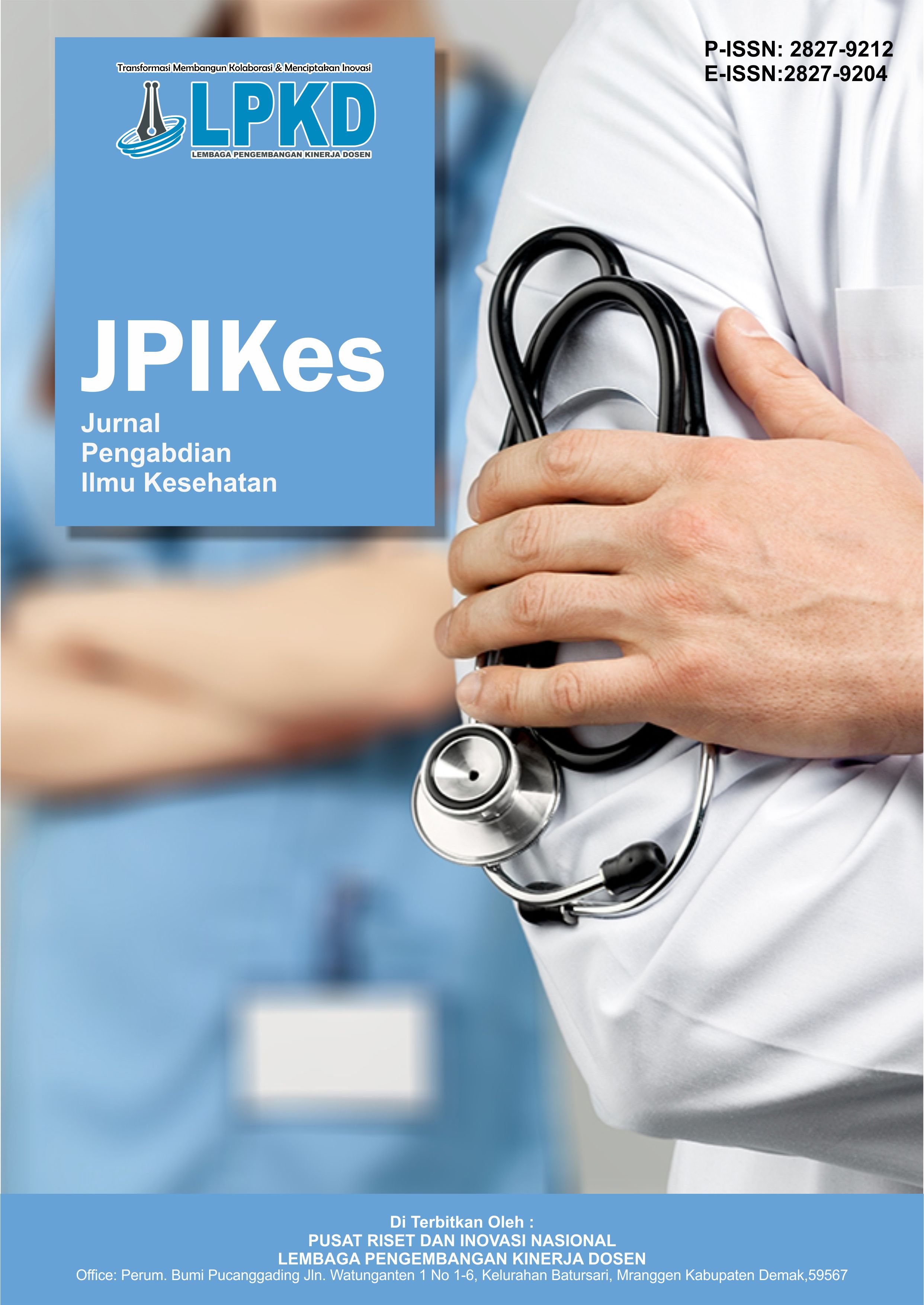Hubungan Tingkat Kecemasan dengan Kejadian Sindrom Dispepsia pada Pasien di Rumah Sakit Annisa Tangerang
DOI:
https://doi.org/10.55606/jpikes.v5i2.5940Keywords:
Anxiety, Digestive Disorders, Dyspepsia, Patients, PsychosomaticAbstract
Dyspepsia is one of the top digestive disorders that are often found in society. The symptoms that arise include pain or discomfort in the heartburn, stomach feels full, nausea, vomiting, satiety, quickly, and often burping. This condition is not only influenced by organic factors, but also closely related to psychosomatic factors, one of which is anxiety. Anxiety can trigger an increase in the hull of stomach acid secretion, motility disorder, as well as a decrease in stomach mucosa function, which exacerbates in dyspepsia symptoms. This study aims to determine the relationship between anxiety levels and the incidence of spsia syndrome in patients at Annisa Tangerang Hospital. This study used quantitative designs with a correlational approach and a cross sectional design. The total population was taken from the last 3 months patient data and the number of samples using the slovin formula with a result of 130 respondents chosen with accidental sampling technique. The research instrument in the form of anxiety-level questionnaire and symptoms questionnaire. The data were analyzed using the Chi Square test with a significance level of p <0.05. The results showed a meaningful connection between anxiety levels and the incidence of dyspepsia syndrome (p = 0.005). This finding is in line with previous research that confirms that psychological factors can worsen digestive condition. The conclusion of this study is that anxiety has an important contribution to the emergence of dyspeptic syndrome. Therefore, the arrangement of patients based on dyspepsia needs to be carried out thoroughly, not only through pharmacological therapies, but also through nursing interventions that pay attention to the patient's psychological aspects. The results of this study are expected to be input for health workers, educational institutions, and subsequent researchers to develop holistic management strategies in reducing the incidence of dyspepsia.
Downloads
References
Aisyah Meidian, S., & Hudi, Y. (2024). Standard pelayanan fasilitas kesehatan (rumah sakit) bagi pasien menurut undang-undang. Jurnal Intelek dan Cendikiawan Nusantara, 2596–2605. https://jicnusantara.com/index.php/jicn
Amalia, D. N., Atmadja, W. L., & Moningkey, S. I. (2024). The effect of anxiety to epigastric pain syndrome and postprandial distress syndrome into medical students of Universitas Pelita Harapan. Journal of Medicine and Health, 6(1), 23–33. https://doi.org/10.28932/jmh.v6i1.7764
Deny Leonardo Natu, I. M. A., & Idwaty Trisno, S. D. T. R. (2022). Hubungan tingkat stres dengan kejadian sindrom dispepsia pada mahasiswa pendidikan profesi dokter Fakultas Kedokteran Universitas Nusa Cendana Kupang. Cendana Medical Journal.
Ellena Nopia Ramdhaniati, Suprihhartini, & Wijayanti Fuad. (2024). Hubungan dispepsia dengan tingkat cemas pada mahasiswa Fakultas Kedokteran Universitas Muhammadiyah Semarang angkatan 2022 menjelang OSCE. Medika Alkhairaat: Jurnal Penelitian Kedokteran dan Kesehatan, 6(2), 460–466. https://doi.org/10.31970/ma.v6i2.188
Haryani, W., & Setyobroto, I. (2022). Modul etika penelitian. In S. S. Tedi Purnama (Ed.), Jurusan Kesehatan Gigi Poltekkes Jakarta I.
Hasan, I. (2022). Analisis data penelitian dengan statistik (Edisi ke-2). PT Bumi Aksara.
Hasanah, N., Diel, M. M., & Mukhaira, I. (2024). Hubungan mutu pelayanan keperawatan dengan tingkat kepuasan keluarga di ruang ICU. Jurnal Kesehatan, 13(1), 1–11. https://doi.org/10.37048/kesehatan.v13i1.268
Ketut Swarjana, S. K. M., & D. P. M. P. H. (2022). Konsep pengetahuan, sikap, perilaku, persepsi, stres, kecemasan, nyeri, dukungan sosial, kepatuhan, motivasi, kepuasan, pandemi COVID-19, akses layanan kesehatan – lengkap dengan konsep teori, cara mengukur variabel dan contoh kuesioner.
Lenga, T. L., Koamesah, S. M. J., Wungouw, H. P. L., & Riwu, M. (2022). Hubungan tingkat kecemasan dengan kejadian dispepsia pada mahasiswa Program Studi Pendidikan Dokter Fakultas Kedokteran Universitas Nusa Cendana. Cendana Medical Journal, 10(1), 113–119. https://doi.org/10.35508/cmj.v10i1.6814
Loliyana, R., Hadi, M., & Meidasari, E. (2023). Pengaruh pelatihan terhadap produktivitas kerja pegawai dengan motivasi sebagai variabel mediasi (pada PT. Nisan Abadi Jaya). Jurnal Manajemen dan Bisnis (JMB), 4(1), 65–74. https://doi.org/10.57084/jmb.v4i1.1052
Mudrikah, K. N., Noor, M., Farida, H., & Asnawati, W. N. (2023). Hubungan keteraturan pola makan dengan sindrom. Homeostasis, 7(1), 119–126.
Muhamad Afifuddin Nur, M. S. (2024). Pengolahan data. Jurnal Ilmiah Sain dan Teknologi, 2, 4–6.
Sugiyono, P. D. (2020). Statistika untuk penelitian.
Putri, A. N., Maria, I., & Mulyadi, D. (2022). Hubungan karakteristik individu, pola makan, dan stres dengan kejadian dispepsia pada mahasiswa Program Studi Kedokteran Universitas Jambi angkatan 2018. Journal of Medical Studies, 2(1), 36–37.
Putri, V. J. P., Izhar, M. D., & Sitanggang, H. D. (2022). Hubungan antara gaya hidup dan stres dengan kejadian sindrom dispepsia pada mahasiswa. Jurnal Ilmu dan Teknologi Kesehatan Terpadu, 2(1), 8–18. https://doi.org/10.24929/fik.v8i2.648
Downloads
Published
How to Cite
Issue
Section
License
Copyright (c) 2025 Jurnal Pengabdian Ilmu Kesehatan

This work is licensed under a Creative Commons Attribution-ShareAlike 4.0 International License.









